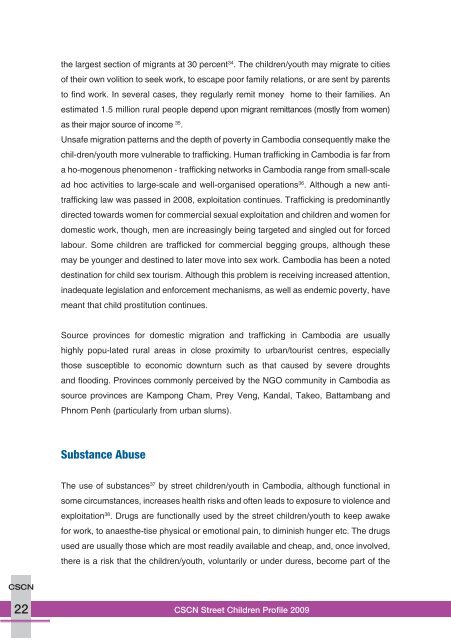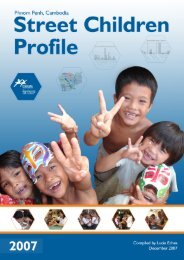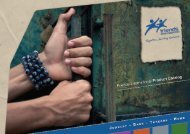Download - Friends International
Download - Friends International
Download - Friends International
Create successful ePaper yourself
Turn your PDF publications into a flip-book with our unique Google optimized e-Paper software.
the largest section of migrants at 30 percent 34 . The children/youth may migrate to cities<br />
of their own volition to seek work, to escape poor family relations, or are sent by parents<br />
to find work. In several cases, they regularly remit money home to their families. An<br />
estimated 1.5 million rural people depend upon migrant remittances (mostly from women)<br />
as their major source of income 35 .<br />
Unsafe migration patterns and the depth of poverty in Cambodia consequently make the<br />
chil-dren/youth more vulnerable to trafficking. Human trafficking in Cambodia is far from<br />
a ho-mogenous phenomenon - trafficking networks in Cambodia range from small-scale<br />
ad hoc activities to large-scale and well-organised operations 36 . Although a new antitrafficking<br />
law was passed in 2008, exploitation continues. Trafficking is predominantly<br />
directed towards women for commercial sexual exploitation and children and women for<br />
domestic work, though, men are increasingly being targeted and singled out for forced<br />
labour. Some children are trafficked for commercial begging groups, although these<br />
may be younger and destined to later move into sex work. Cambodia has been a noted<br />
destination for child sex tourism. Although this problem is receiving increased attention,<br />
inadequate legislation and enforcement mechanisms, as well as endemic poverty, have<br />
meant that child prostitution continues.<br />
Source provinces for domestic migration and trafficking in Cambodia are usually<br />
highly popu-lated rural areas in close proximity to urban/tourist centres, especially<br />
those susceptible to economic downturn such as that caused by severe droughts<br />
and flooding. Provinces commonly perceived by the NGO community in Cambodia as<br />
source provinces are Kampong Cham, Prey Veng, Kandal, Takeo, Battambang and<br />
Phnom Penh (particularly from urban slums).<br />
Substance Abuse<br />
The use of substances 37 by street children/youth in Cambodia, although functional in<br />
some circumstances, increases health risks and often leads to exposure to violence and<br />
exploitation 38 . Drugs are functionally used by the street children/youth to keep awake<br />
for work, to anaesthe-tise physical or emotional pain, to diminish hunger etc. The drugs<br />
used are usually those which are most readily available and cheap, and, once involved,<br />
there is a risk that the children/youth, voluntarily or under duress, become part of the<br />
CSCN<br />
22 CSCN Street Children Profile 2009






